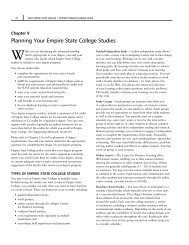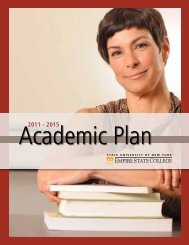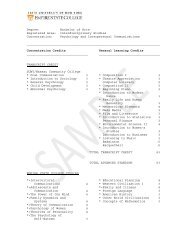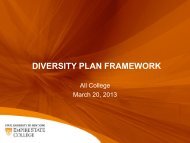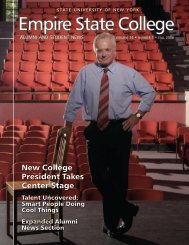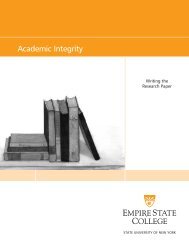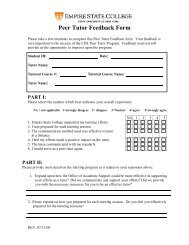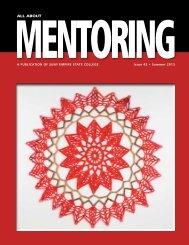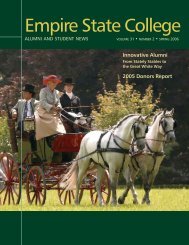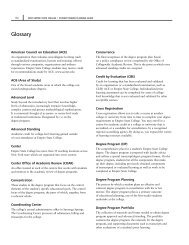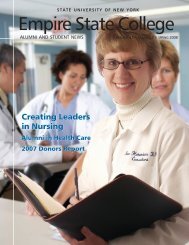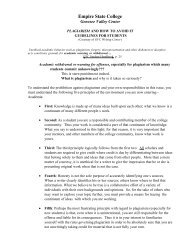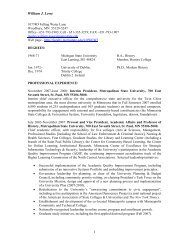All About Mentoring Spring 2011 - SUNY Empire State College
All About Mentoring Spring 2011 - SUNY Empire State College
All About Mentoring Spring 2011 - SUNY Empire State College
You also want an ePaper? Increase the reach of your titles
YUMPU automatically turns print PDFs into web optimized ePapers that Google loves.
16<br />
resources that provide superb step-by-step<br />
instructions in video and with screencasts<br />
using a wide range of the very tools students<br />
are learning to master. In addition, digital<br />
media online courses have a student café in<br />
which students help each other learn some<br />
of the more difficult aspects of using Twitter<br />
and other social media tools.<br />
Students typically enroll in this popular<br />
study with a wide range of skill sets. Some<br />
students start the course with excellent<br />
writing skills – superb writers, expressing<br />
an interest in writing and storytelling,<br />
but tentative about their limited digital<br />
skills. Other students begin stronger on<br />
the technical side, with less confidence<br />
in their ability to write a good story. The<br />
shared student spaces in this study provide<br />
them with the opportunity to express their<br />
concerns and share their work with their<br />
peers. This highly supportive environment<br />
allows students to share strategies and<br />
provide feedback on the development of<br />
each other’s projects, which is a wonderful<br />
preparation for peer critique.<br />
One way to foster critical analysis,<br />
evaluation and thinking is through the<br />
implementation of carefully designed rubrics<br />
that allow students to participate in peer<br />
critique and evaluate digital media artifacts.<br />
For example, in the Digital Storytelling<br />
course, students apply a digital storytelling<br />
rubric to the review and evaluation of<br />
professional digital stories, as well as those<br />
of their peers. The rubric used in CDL<br />
studies was adapted from a tool created<br />
to evaluate digital stories at the University<br />
of Houston. 2 A wonderful side effect of<br />
applying this rubric to the analysis of<br />
different story projects is that students<br />
gain a strong grasp of commonly accepted<br />
criteria for the creation of digital stories as<br />
they evaluate them. It helps them understand<br />
where their own stories fit within the<br />
spectrum of other digital narratives.<br />
This type of course, which has a focus on<br />
both storytelling and digital media mastery,<br />
provides all levels of students with the<br />
opportunity and skills to gradually acquire<br />
competency and literacy as the study<br />
evolves. In my experience, even the student<br />
with the least technical skill among her peers<br />
has been able to create a blog; learn Twitter;<br />
review, research and evaluate digital media<br />
resources; and create digital stories that<br />
combine elements of written narrative, audio<br />
commentating, visual resources, moving<br />
images and music. <strong>All</strong> of these skills form<br />
the building blocks of digital media literacy.<br />
Digital Art and Design, Introductory and<br />
Advanced. These courses have been revised<br />
to include a stronger emphasis on applying<br />
social responsibility and ethical principles,<br />
peer critique, blogging (as a platform<br />
for portfolio development and artistic<br />
statements) and close analysis.<br />
Information Design. This course has been<br />
substantially revised to include all of the<br />
recommended practices of digital and media<br />
literacy education, along with stronger<br />
theoretical foundations and emphasis on<br />
contemporary mixed media practices.<br />
History and Theory of New Media. This<br />
was a guided independent study using the<br />
now defunct Google Wave (incorporated<br />
at the request of the student, when Wave<br />
was in its early experimental stages). This<br />
was a very successful study in which the<br />
student communicated privately with me<br />
using Google Wave, a rich and flexible<br />
environment that supported integration<br />
with most types of media, and allowed<br />
for both simultaneous and asynchronous<br />
dialogue. Students included their preliminary<br />
reflections, research, experimentation and<br />
dialogue in the Google Wave environment,<br />
but selected a number of other tools to assist<br />
with their study. Once refined, research<br />
and reflective statements were published<br />
on student blogs. This study is now being<br />
proposed as a CDL course using alternative<br />
media environments to create personalized<br />
learning experiences.<br />
Studies in Mobile Media. This is a new<br />
set of guided independent studies open to<br />
students across the college. Current students<br />
are working on independent projects using<br />
a variety of mobile media. For example,<br />
one student is focusing on the medium for<br />
artistic expression using photography and<br />
video. Another is applying the study to<br />
create the research foundation for a business<br />
application. The text for this course, Mobile<br />
Technologies: From Telecommunications to<br />
Media (Goggin, 2008), provides a critical<br />
analysis for the use of mobile media in<br />
global contexts, thus applying the principles<br />
of teaching digital and media literacy<br />
described above.<br />
V. Danger Zones<br />
The flip side of digital and media literacy<br />
is that access to unfiltered information<br />
puts the student at risk of encountering<br />
compromising content, behaviors and<br />
practices. Staksrud, Livingstone, Haddon,<br />
and Ólafsson (2009, p. 18) and Hobbs<br />
(2010, p. 29) wrote a comprehensive report<br />
on research of children’s use of online<br />
technologies in which they categorize<br />
associated risks in three areas: content,<br />
contact and conduct (see table below).<br />
Content Risks<br />
This includes exposure to potentially<br />
offensive or harmful content, including<br />
violent, sexual, sexist, racist or hate<br />
material.<br />
Contact Risks<br />
This includes practices where people<br />
engage in harassment, cyber bullying and<br />
cyber stalking; talk with strangers; or<br />
violate privacy.<br />
Conduct Risks<br />
This includes lying or intentionally<br />
misinforming people, giving out personal<br />
information, illegal downloading,<br />
gambling, hacking and more.<br />
suny empire state college • all about mentoring • issue 39 • spring <strong>2011</strong>




